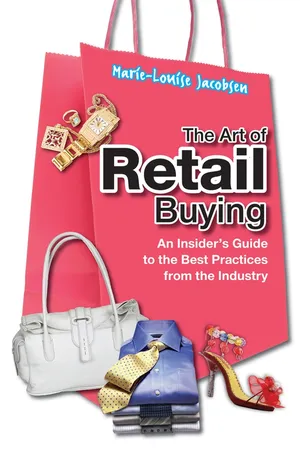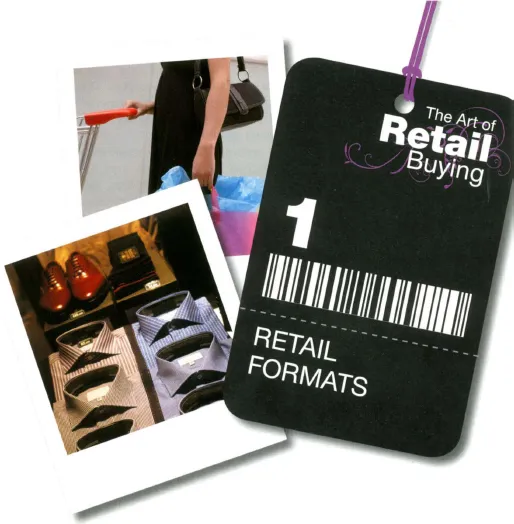![]()
What it Takes
Before we look at the various organizational structures within which buyers are called upon to operate, it might perhaps be useful to say a few words about the personal qualities and characteristics that contribute to making a good and successful buyer.
In my experience, anyone wanting to engage in a retail buying role should have a creative and extrovert personality, be a natural problem solver and be able to handle a high level of multi-tasking. Retail buyers must be able to understand and predict customers’ needs and the saleability of a wide selection of products based on cost, style, function and quality while, at the same time, comparing these to other similar products available in the market. This is a significant task because they must order items months ahead of time, which requires a great deal of calculated risk based on experience and, more often than not, on sheer gut feeling.
Buyers need to put aside personal tastes and preferences and focus solely on what they anticipate customers will buy, in what quantities and at what premium. In making these choices, they also have to do so within specific purchasing budgets. A great deal of self-confidence is needed. Buyers eventually become experts in the merchandise categories they are buying for. After an initial trial-and-error period, they come to know what to buy, how to buy and where to buy, narrowing down wide selections of resources and knowing the best places to buy.
A retail buyer works in a dynamic but sometimes stressful atmosphere where decisions are made hourly. There can also be long and irregular hours, especially during holidays. Work is always fast-paced and competitive, and the buyer must quickly estimate the potential profitability of many products.
These conditions may vary, depending on the size and type of the organization for which the buyer works. Large department stores and chain stores require a buyer to plan, buy, and ensure that the sales staff is knowledgeable about the products. The role is, however, supported by back-office roles such as assistant buyers, visual merchandisers and other operational functions.
In a small store, a buyer may hold more than one position which, besides buying, may include advertising, floor and window displays, hiring new employees and training.
The roles of the buyer can be many and varied, being determined by factors such as the size of the company (the number and locations of outlets); the number of staff; the yearly revenue; and the merchandise classifications. Set out below are some of the many types of retail organization in which buyers may choose to shape a career.
Retail Formats
Hypermarkets/Supermarkets
Hypermarkets are big business and growing fast in Asia. Asian consumers have changed their shopping habits, moving away from traditional wet-markets to the comfort of hypermarkets/supermarkets, which provide a wide selection of goods in pleasant surroundings, and where the freshness of meat and vegetables is assured.
Hypermarkets in Asia can be home-grown like Mydin in Malaysia, or local start-ups such as Dairy Farm that grew to regional reach, or imported concepts such as Tesco, Carrefour and Jusco.
What they all have in common is that they sell “general” merchandise that includes perishables, household items, hardware, toys, small electronics, clothing, toiletries, cosmetics, furnishings and furniture, and more. They all boast of either being the cheapest or, at least, of offering the best value for money.
Discount stores
Discount stores are stores that sell local or regional brands at lower than market price points. They can have a wide mix of goods or concentrate on specific merchandise types. More often than not, they will buy season-end merchandise, job lots and/or secondary brands. Merchants are required to hunt for deals regionally and buy in bulk to get the lowest price possible.
Factory outlets have been developed by the brand owners to release their own discounted season-end goods. The benefit lies in the control of the retail price this gives and thus leads to better profits.
What, then, is the difference between a hypermarket and a discount store? Comparative research has shown that the hypermarkets tend to have higher mean prices, but use promotional tools more often and more widely than the discount stores. Hypermarkets use promotional areas with strong signage that gives the impression that they are cheaper because they have the muscle to buy big and are thus able to offer bigger discounts. The advantage hypermarkets have is in the depth and width of the products on offer, which make it practical for consumers to shop there.
Department stores
Department stores come in two types: those with a full-line designation, which carry a wide range of merchandise, from health and beauty to fashion/softgoods and accessories, to household and small electrical items/hardgoods and, occasionally, specialty gourmet foods; or those dedicated to specific brands or products. Department stores may have stores within the store, like shop-n-shops, ID-shops or specialist sections.
Because the department store serves as “the umbrella” for a wide assortment of goods, it is deemed convenient for customers to shop there.
While some department stores may concentrate on specific merchandise types, such as apparel and accessories, in the majority of cases they, like other retailers, need to decide which customer profile they intend to pursue and buy accordingly.
The vulnerability of today’s department stores is that they have a hard time competing with true branded stores (see below). Customers are becoming increasingly fussy, and without very good service and merchandise that can give them points of differentiation, department stores may lose their edge. To maintain customer loyalty, some stores have adopted store credit cards and created special card-member events with special offerings or discounts to reinforce loyalty and consumer spending. The balancing act, though, is not to use such marketing tactics too often; otherwise, consumers can become blasé with yet another discounting event.
Branded stores
Branded stores are those that carry single known brands. These may be globally or nationally renowned brands such as Nike, Adidas, Esprit, Mango, Zara, Timberland, Levis’, and H&M; or “high-end” brands such as Gucci, Prada, Fendi and Burberry. These stores are either operated directly by the brand owners or through a franchise agreement.
The merchandise, price points, store layout, store design, store locations and merchandise displays are usually strictly spelt out by the Master Licensee or brand owner. Customer service is high and specialized. These stores are usually located in “choice” areas, streets or malls, with the stores designed specifically to encapsulate the mood of the brand. Customer loyalty is linked to brand loyalty which, in turn, gives the consumers a sense of identity with the brand. Branded stores lose their customers when they start losing their luster. I call these “sunset brands”: in most cases, the brand has either lost touch with its customers, or the customers have graduated from them and moved on to other brands that are more in tune with their lifestyle.
Single-unit independents
This trend is still big business in retailing. There are still many entrepreneurs who wish to be their own boss. Many of them are very successful, as they are able to cater very specifically to their customers’ needs and give them personalized services.
The merchandise, similar to that in specialty stores, is usually limited in choice but appealing nevertheless. The “boutiques” can carry ranges of shoes, jewelry or apparel, which are usually higher-priced goods and sometimes custom-made.
Initially, the owners themselves usually act as the buyers but, as the business grows, they may expand this role to incorporate hired professional buyers.
Specialty stores
Specialty stores are, as the name suggests, stores that specialize in specific types of merchandise, with a specific lifestyle offering. These can vary from luxury goods to mid-priced high-quality goods at commercial price points. Examples include sports shops, dive shops, telecoms shops, book stores, branded cosmetics (a new trend in the health & beauty industry), antique shops, oriental carpet shops and shoe shops, to name but a few. Here the attraction is that customers shop these stores as a destination shopping trip. The expectation is that they must have a wide choice of merchandise within their respective specialist categories and very knowledgeable staff who can recommend the right items.
The specialist stores are vulnerable to competition from general merchandising retailers who may opt to have some specialist sections for which they are sometimes able to buy in bulk and sell these items quite cheaply, creating price mayhem with point-of-no-return price levels (the point at which an item has been discounted so often that it can no longer command its original price). For example, pashmina shawls used to retail at $500 when they first came on the market. Big retailers then bought these in bulk and sold them at $300; other retailers discounted them further to $200, and today they can be as low as $150. In such circumstances, they can no longer command their original value of $500: the price has gone down to a point of no return.
Specialty stores are compelled to know a great deal about their customers and their individual requirements. There is usually a great deal of customer follow-up and special purchases on customers’ behalf.
Franchised stores
When the owners/developers of a concept or brand wish to expand the business into other territories or countries, they often adopt the franchising business model under which, for a fee, the franchisee is given the right to operate the retail concept in very specific locations (regions). This retail operation is conducted under specific rules and regulations that have been set out by the owners (the franchisors).
Franchises abound in the fast-food industry—McDonald’s, Wendy’s, Kentucky Fried Chicken, and Starbucks—but are also found in the fashion industry—Zara, Mango, Debenham’s, Tommy Hilfiger and more.
Catalog retailing
Catalog selling is still very popular, especially in the United States. Examples in Asia include Ikea and Lands’ End.
Some department stores feature merchandise that is only available through this channel and thus will have separate buyers purchasing for the catalog business.
Some retailers in the United States use only catalogs as a means to reach their customers, with the exception of a few factory outlets to dispose of slow-moving merchandise.
License stores
Licensing is similar to franchising, with the main difference being the start-up fee. Some of the best-known of such arrangements include Benetton—the largest retail licenser in the world—Ralph Lauren, and Marks & Spencer.
Here the licensees are required to follow the merchandising philosophies established by the licensors, and the buyer’s role is quite different from any other retailing format. The merchandise sold is either produced completely by the licensee—in which case the buyer needs to be able to do product development—or purchased directly from the licensor (the original brand owner) by the licensee’s buyer for distribution to the individual units. Generally, the individual stores have no buying responsibilities. Today, increasingly, licensors adopt a “push-model,” under which the licensee gives the licensor an open-to-buy (OTB) budget (OTB being the difference between planned purchases and stock already ordered, or the value ...


